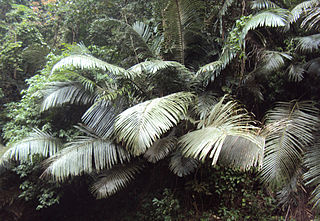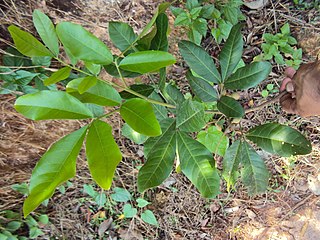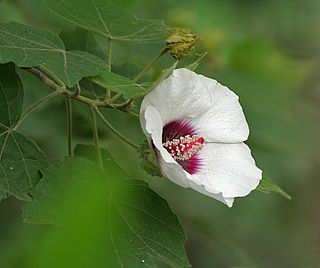
The Lamiales are an order in the asterid group of dicotyledonous flowering plants. It includes about 23,810 species, 1,059 genera, and is divided into about 24 families. Well-known or economically important members of this order include lavender, lilac, olive, jasmine, the ash tree, teak, snapdragon, sesame, psyllium, garden sage, and a number of table herbs such as mint, basil, and rosemary.

The Piperaceae, also known as the pepper family, are a large family of flowering plants. The group contains roughly 3,600 currently accepted species in 5 genera. The vast majority of peppers can be found within the two main genera: Piper and Peperomia.

Heritiera littoralis, the looking-glass mangrove is a large tree with wing shaped nuts, which is most easily recognised by the silvery scales on the underside of its leaves, which therefore appear green from top and white from below, although Litsea mellifera A.C. Smith, has the same type of leaves. The tree is usually found to grow along the seashore in Bangladesh & Indian Subcontinent, Southeast Asia and Tropical Africa.

Ethiopia has a large variety of indigenous plant and animal species. In some areas, the mountains are covered with shrubs such as pyracantha, jasmine, poinsettia, and a varied assortment of evergreens. Caraway, carcade, cardamom, chat, coriander, incense, myrrh, and red pepper are common. The lakes in the Great Rift Valley region abound with numerous species of birds, and wild animals are found in every region. Among the latter are the leopard, cheetah, lion, civet, serval, African bush elephant, bushpig, gazelle, antelope, ibex, kudu, dik-dik, oribi, reedbuck, Somali wild ass, Grévy's zebra, hyena, baboon, and numerous species of monkey. As of 2002, there were at least 277 species of mammals, 262 species of birds, and over 6,600 species of plants throughout the country.

Arenga wightii is a species of flowering plant in the family Arecaceae. It is found almost exclusively in India. It is threatened by habitat loss.
Aglaia apiocarpa is a species of plant in the family Meliaceae. It is found in Southern India and Sri Lanka.

Aglaia elaeagnoidea, the droopy leaf or priyangu, is a species of plant in the family Meliaceae. It is a 10m tall tree found in American Samoa, Australia, Cambodia, India, Indonesia, Malaysia, New Caledonia, Papua New Guinea, the Philippines, Samoa, Sri Lanka, Taiwan, Thailand, Vanuatu, and Vietnam.
Agrostistachys borneensis is a species of plant in the family Euphorbiaceae. It is a widespread plant native to much of Southeast Asia as well as India, Sri Lanka, and New Guinea.

Aporosa bourdillonii is a species of plant in the family Phyllanthaceae. It is endemic to India. It prefers evergreen and semi-evergreen forests.

Grevillea australis, the Southern grevillea, is a species of flowering plant in the family Protaceae. The only Grevillea to occur naturally in Tasmania, it also grows in highland areas of south-eastern mainland Australia. It has several variations in the wild, and is therefore a very variable species.

Chukrasia tabularis, the Indian mahogany, is a deciduous, tropical forest tree species in the family Meliaceae. It is native to Bangladesh, Cambodia, China, India, Indonesia, Laos, Malaysia, Myanmar, Sri Lanka, Thailand, and Vietnam. Also introduced to many western countries such as Cameroon, Costa Rica, Nigeria, Puerto Rico, South Africa, and United States.

Huberantha korinti is a species of plant in the Annonaceae family. It is native to South Asia.

Huberantha cerasoides is a species of trees in the family Annonaceae and tribe Miliuseae. It is the type species of the relatively new genus Huberantha.

Monoon coffeoides is a species of plant in the Annonaceae family. It is a synonym of Polyalthia coffeoides and found in southern India and Sri Lanka.

Celtis philippensis, is an Asian species of flowering plant in the family Cannabaceae.
Mallotus rhamnifolius, the buckthorn-leaved kamala, is a species of understory, evergreen plant in the family Euphorbiaceae. It is native to Western Ghats of India and Sri Lanka.
Mallotus resinosus, the resinous kamala , is a species of 12m tall shrub, evergreen plant in the family Euphorbiaceae. It is native to India, Sri Lanka to New Guinea and Australia. The plant is known as "கருவாளிச்சீ / karuvalichchi" by Tamil people.

Hibiscus platanifolius, the maple-leaved mallow, is a species of flowering tree in the mallow family, Malvaceae, that is native to the India and Sri Lanka. In Sri Lankan texts, the plant is widely known by its synonym H. eriocarpus. The tree is about 8m tall. Leaves are cordate at base; hairy; trilobed. Flowers show axillary panicles where flowers show typical Hibiscus flower colors, pink with dark center. Fruit is a capsule.

Heynea trifolia is a tree in the family Meliaceae. The correct scientific name is unresolved up to date, where some name the plant as Heynea trifolia and some others as Walsura trifoliolata. The above classification is according to The Plant List. The specific epithet trifolia is due to trifoliate leaves. The plant is native to India and Sri Lanka.















